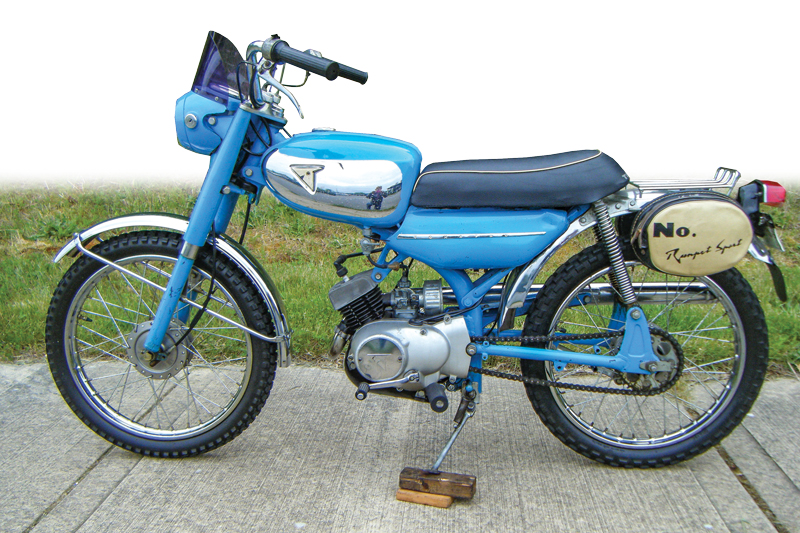
This little charmer was in the first wave of Japanese bikes to enter the U.S. market, thanks to Hap Jones, a motorcycle racer and businessman of considerable note. Hap had been selling British bikes in the 1950s, and then decided to get out of the retail business, focusing on his more profitable distribution side. And the Japanese manufacturers were just getting interested in American buying habits, with Honda opening up for business in 1959, Yamaha in 1960.
So Hap got on the phone to Japan in 1961 and had a chat with the Tohatsu suits, who were undoubtedly very happy at the thought of getting into the burgeoning U.S. market, especially with a well-known and highly respected gent like Hap Jones. They arranged for a couple of 50cc Runpet models and several 125s to be sent over, a deal was struck and Hap introduced them to the world with a full-page ad in the January 1962 issue of “Cycle” magazine…quite unusual for a start-up to spend that kind of money. Then he had the good fortune to have a rider on a Tohatsu 125 win the lightweight Sportsman road race at Daytona, which gave him great publicity. Within a few months he claimed to have 300 motorcycle dealers and a number of sporting-goods stores carrying the Tohatsu line.
What was this little Runpet Sport? And this Tohatsu Company? The word is a combination of Tokyo and “hatsudoki” (engine factory), the origins going back to 1922 and the Takata Motor Research Corp., which made its reputation by building a small motor for a highly successful rail-track car. The name was changed to Tohatsu in 1939, and the company became focused on producing military equipment, including small motors to run little generators. War came and went, the factory survived, and it began selling these little motors to other companies building motorized bicycles. “Heck, we can do that ourselves,” some executive said, and Tohatsu began selling kits for bicycle owners to mount themselves, with gas tank, exhaust system and bracketry.
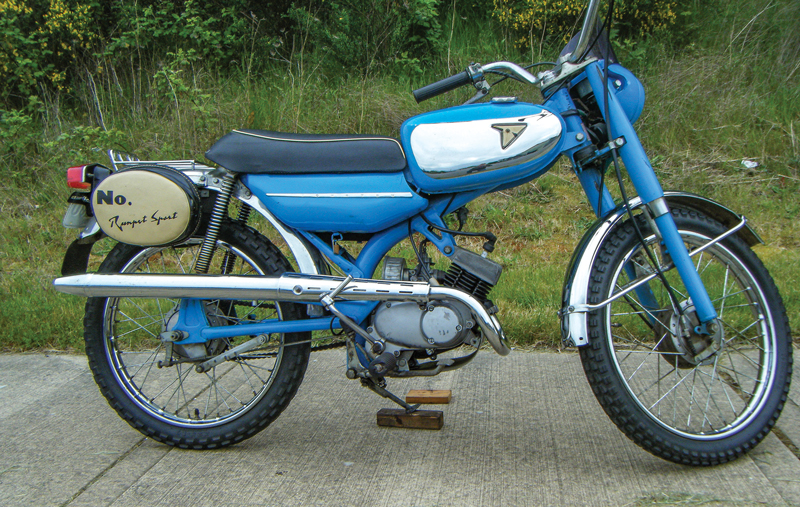
Better yet, it would build a sturdy bicycle, with a telescopic fork. In 1953 the Puppy appeared, powered by a 58cc two-stroke. Not a very attractive vehicle, but mildly efficient. In the mid-’50s the Japanese were all desirous of personal transportation and some 80 companies were competing in the motorized two-wheeler market. By 1956 Tohatsu was the biggest of the lot, selling 70,000 motorbikes, twice the number that Honda was. But competition was getting fierce, and the serious outfits like Honda, Yamaha and Bridgestone were busy modernizing their products, while dozens of the small operations were shutting down. Unfortunately Tohatsu’s success was followed by some major financial mismanagement, with lots of borrowing going on to keep the company afloat. In 1960 the government, through something called the Rehabilitation Act, arranged for Tohatsu to be bought by the Fuji Electric Manufacturing Corporation, the presumption being that this larger concern might be able to get Tohatsu back on its financial feet.
Motorcycles were just a part of the Tohatsu Company, with marine hardware, from bilge pumps to outboard motors, being more important. However, the two-wheeler R&D boys had been hard at work with new models now at hand, including the 50cc Runpets, the Japanese advertising saying in translation, “…with the accent on having fun!”
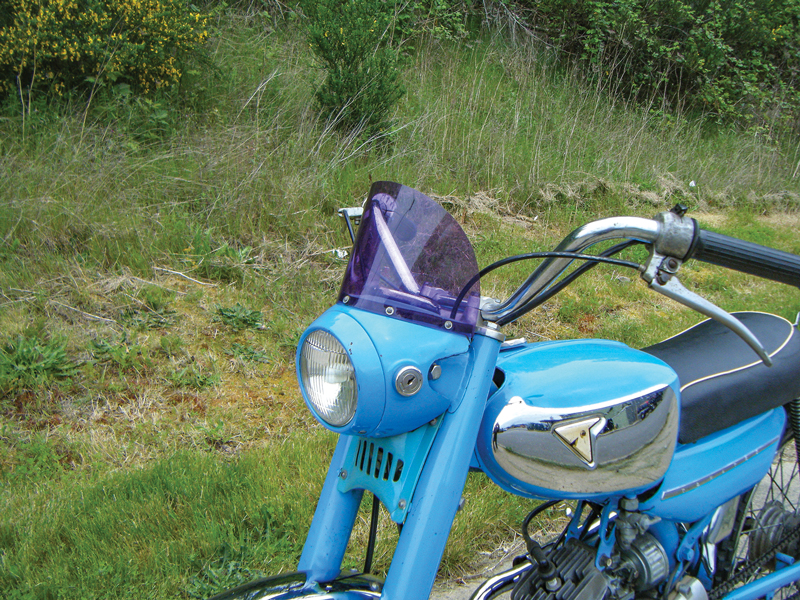
The Runpet Sport was indeed a sporty creature, with a highly tuned 49cc piston-port engine, fed through a TK carburetor that, like the Amals of the day, had both a tickler and a choke. A single-disc clutch connected to a three-speed gearbox. The factory claimed it put out 6.8 horsepower at 10,800 rpm and was capable of speeds in excess of 60 mph. Quite astounding for a street-worthy little single! It should be noted that 50cc racing was quite popular back then, especially in Japan.
Unfortunately Tohatsu did not get into developing automatic oiling, and owners had to do things the un-fun way, mixing the oil with the gas. As well as kickstarting the tiny terror. Tohatsu had put an electric starter on its basic Runpet with a lower state of tune, intended for the commuter and housewife, but the Sport was to live up to its name.
Chassis was simple, with a large tubular steel backbone frame from which the engine hung, two bolts securing the head; two more were down at the back close to the swingarm pivot. A telescopic fork up front. Two pairs of arms went back from the main frame to hold the saddle and places for bolting the tops of the two shock absorbers.
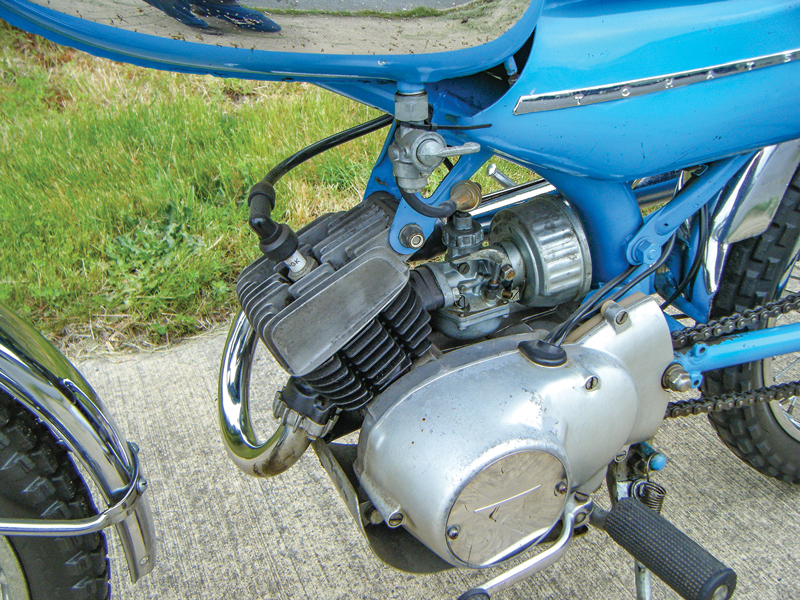
The 17-inch wheels had drum brakes, and the distance between axles was 44.5 inches. A 100 mph speedometer (rather optimistic) sat in the headlight nacelle, and a very small windshield served to enhance the sport look. A short saddle and no passenger pegs indicated that this was a one-up ride. But you could get the groceries, as there was a small luggage rack and two tiny pannier bags, made from the hide of a Nauga. Total weight was 135 pounds.
There were several options as to presentation, and this one has the scramblerish high pipe and small skid plate. Shiny chrome fenders and nice paint on the tank and side panels enhanced the image. The company was also putting out new two-stroke models, designed with American riders in mind, like a 125 parallel twin with four gears and 15 horsepower.
All to no avail. Bankruptcy was declared in 1964 and the motorcycle side was shut down. We don’t know how many Runpet Sports were sold by the 300 dealers Hap Jones claimed were carrying the brand, but there don’t seem to be many in the used-bike lists.


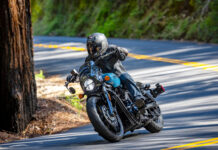






how rare are the orange tohatsu 50 trailmaster thank you for your time
My first motorcycle was a 1963 Tohatsu. It would beat a Honda Super 90.
Those bikes ran well. In 63 rode mine all over Lockwood valley, Ca.. And Playa Del rey and Hughes field.
My dad was one of those 300 dealers when I was a teenager. So, I was fortunate to have had great times riding all of the Tohatsu models. Dad’s store was in Sedro Wooley, Wa. This brings back many very for dinner memories. Love the pictures.
Looking for a wiring diagram for mine. Also what carburetor is on these?
I have one that looks exactly like the one in the picture. Not sure exactly what year it is. But the license plate has 1962 and 1964 stickers on it. Does anyone have a wiring diagram fir the bike /battery?
I had a Tohatsu Trailmaster in High School in SoCal 1963. I modified it by porting and added a DelOrto carb. I did not use the low gear sprocket much as most of my riding was on the flats. Traded it for a Tohatsu Sport 125 16.5 HP dual carb engine and double leading shoe front drum brake.
Had a new 62 50 cc Runpet. Would like to find a good one now
Had a few of these Tohatsu Motorcycles back in the day. Wouldn’t mind having my old 125 twin back. Problem with thee bikes is not only availability of the used bikes, but there are no parts. Nobody kept the brand going for the collectors by maintaining a parts stock. This is why I do not seek out these bikes. There just are none to speak of.
I have the owner’s manuals for these bikes, as well as a few of the service/parts manuals. I might have the electrical and carb information, if you still need it.
I have the same machine as Cal Stender’s 1963 Tohatsu Trialmaster. Would like any info or buy any manuals on the Trialmaster. Please contact me at hrwhiter@hotmail.ca or phone 403-581-7644. THANK YOU
Flint Indian Sales Flint, Michigan sold these in the 60’s I worked on several of them Flint Indian Sales was in business from 1928 to 1962 I settled the estate for the owner Herb L. Kunze I had worked there on & off for nearly 16 years – We sold Indians, Enfields, Zundapp, Norton’s , Matchless, AJS, MotoGuzzi, Penton’s/KTM, JBK, Ducati’s plus Wayne Tingley aka Ting
There was a Tohatsu trail that was new in the crate, I attended GMI and loved to visit the store when it was open.
My lifelong friend, (passed in ‘99) was one of those dealers, set up by Hap Jones ,of the Tohstsu 50cc Runpet bikes in Little Rock AR, about 1962.
I bought the very first one he sold, and took it to south Florida and later to Utah , eventually, in 72, traded in on new Yamaha 125 scrambler, for trip down the Baja.
Would love to find a good Runpet for sale
Had one when I was stationed at MCAS Iwakuni, Japan in 1962. Good little bike for the roads there. I have pictures but no way to put them on here. They are on my website listed below.
I have the same machine as Cal Stender’s 1963 Tohatsu Trialmaster. Would like any info or buy any manuals on the Trialmaster. Please contact me at hrwhiter@hotmail.ca or phone 403-581-7644. THANK YOU
I ode one around the outer Islands of Hawaii circa 1962. Here is my story;
CAMPING ON MAUI+
Sleeping on the Sand (Can be comfortable)
During my travels on Maui and other Outer Islands, I traveled by minibike. It was a Tohatsu Runpet Sport 50cc I took just the minimum amount of lightweight sleeping gear needed to have a nice economical vacation. After a short time I figured out that all I needed was an army surplus rain poncho and a large double bedspread.
The temperature in the Islands in the 60s, varied by only about 5° from day time to the evening and it is about 5° warmer in the summer than the winter, so when I traveled during the summer I really didn’t need any more bedding than the above.
Most of the time I would spread the poncho out on the sand and use the bedspread as a cover, not so much for warmth, but to keep any mosquitoes away if they were present. If it rained I did the reverse and put down the bedspread on top of the soft sand and then spread the poncho out on top of me to keep the rain off. On the good side, it very seldom rained. Most of the rain falls on the higher elevations.
The one exception was when I was on the Big Island in the City of Hilo. I was trying to sleep in an area that turned out to be off-limits because of the risk of a big flood as seen in the previous Tsunami. I did not know this. I pulled my little Tohatsu mini bike into the park and spread my bed gear out on the grass under a nice looking tree. I had something to eat and fell asleep. Since my poncho kept me dry I thought everything was ok, but after a while the rain made the grass soggy, to the point where it started creeping in underneath me.
I got up and moved into a small pump house building with no doors and a cement floor. It was not very comfortable but at least it was out of the rain. After a while a patrolman came by and let me know about the laws and how it was dangerous to be in that area in case of another Tsunami. Luckily for me in Hawaiian style, he said ok, you can stay here but you’ll have to leave early in the morning.
As I rode my 50 cc Tohatsu bike away the next morning, I noticed a hotel in the affected area that was still open. I took a closer look and I noticed that it was raised up in a way that made it look like there were carports below. The first floor lobby was up one floor from the beach. Apparently this allowed it to be safe from any future Tsunami.
The next Evening, it was time to find a place to stay indoors. I asked around for an economical place and I found out that there was a Japanese Tea House that would let me to stay over as long as I was willing to go through the Japanese tea ceremony. It was interesting and quite different. I enjoyed my stay there. Afterwards I did some more traveling around visiting waterfalls and nature parks on the Bog Island.
Great web site, I have owned several Tohatsu, only have 1 Tohatsu gas tank emblem
I had a 1962 Tohatsu Runpet Sport bought from Goodman”s Cycle in Winter Park Florida. For a 50cc bike it would fly!
I have 3 of these I would like to sell as a lot. Have bags and windshield too. They are in rough shape but would make a great project. SF Bay Area, local pickup only. Email Karlznet@aol.com for photos and more info.